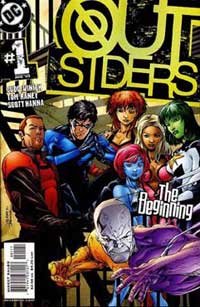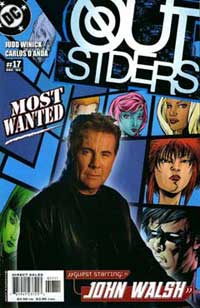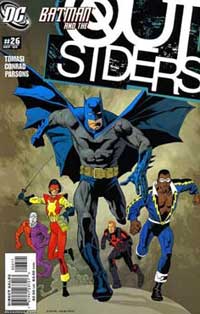Looking In on the Outsiders, pt. 2
By Philip Schweier
June 28, 2013 - 20:04
About 10 years ago (really?), I wrote Part 1 of this article,
beginning with, “Any first issue needs to hit the ground running. If you were
to ask me if The Outsiders #1 did that, I couldn't tell you.”
Well, boy howdy, I can tell you now!
Y’see, Mrs. Wife and I were doing some clearing out of the excess miscellanea
we have floating around the house, and I decided to take a look at some of my
comics, to see if there was anything I could live without. I started with Judd
Winick’s run on the Outsiders (2003). I must say, reading
all 31 issues back-to-back was quite the eye-opener as to how good a series it
was.
The first issue opens with Arsenal trying to convince Nightwing to join him in
forming a new team of heroes. Nightwing is reluctant, having suffered terrible
losses while a member of the Teen Titans/New Titans/Titans/Team Titans.
Nevertheless, Arsenal is able to convince him that the new team will focus on
work, without the family dynamics they experienced with the Titans.
The two former sidekicks join a roster that includes other legacy heroes: Jade,
the daughter of the original Green Lantern; Thunder, the daughter of Black
Lightning, one of the original Outsiders; a fellow Outsider original,
Metamorpho, and newcomers Grace Choi (no flashy name or costume for her. A
serious beatdown makes her presence known), and Indigo, a cybernetic being from
the future who Nightwing blames for the death of long-time Titan teammate Donna
Troy. But Arsenal insists she’s been reprogrammed.
Following their first adventure, in which Gorilla Grodd attacks New York City
as a distraction for the Joker to kidnap then-President Lex Luthor, Nightwing
meets with Batman, saying that the world has enough firemen. His new team will
be hunters, seeking out bad guys who are plotting evil when they should be
behind bars.
Unfortunately, those bars are rather temporary as the new team is blamed for
the destruction of the Slab, a meta-human prison located in Antarctica.
Hundreds of super-villains escape, thanks to Titans nemesis Brother Blood.
Shortly afterward, Metamorpho shows up – No, the REAL one. It seems the
Metamorpho we’ve been seeing is actually a fragment of the original. Following
a calamity in space, thousands of bits of Rex Mason rained down on Earth. One
of them reformed itself and while its memories were hazy, it believed itself to
be the original. Not so, and the “real” Element Man wants it back.
But identity is a funny thing, and the “fragment” has become a living,
breathing person who is able to impress his “father” that he’s a chip off the
old block – literally. He adopts the name Shift and begins a romance with
another “constructed being,” his teammate, Indigo.
More legacies join, as the Huntress steps in when Arsenal is severely wounded.
Captain Marvel Jr. helps out when his demonic nemesis Sabbac is resurrected in
an even more frightening form. But it’s not just the heroes who are presented.
The Fearsome Five returns, thanks to the machinations of Dr. Sivana.
Much of this revisiting of DC Comics legacy heroes is due to Judd
Winick. Often, when a writer is granted the opportunity, we read quotes of how
he “gets to play with all the toys in the toy box.” Winnick took that analogy
and ran with it. But he is not without his more serious side, as he
guest-starred John Walsh in a story depicting the kidnapping and sexual abuse
of children. It was poignant, and offered a peek into the background of the
(usually) invulnerable Grace.
Nightwing’s role as leader was challenged by Jade as she accused him of not
caring enough about the team members in the wake of a series of injuries that
sidelined one teammate after another. She takes over, and her first act is to
recruit Nightwing’s former love, Starfire, perhaps has a means of keeping him
in check.
The Outsiders were a different kind of team, in that its mission was not
entirely altruistic. Each member drew a salary from Optitron, the company that
financed the group. And why would a corporation bankroll a team of
super-heroes? For the same reason it might put its name on a sports arena: to
give the appearance of having a social conscience.
But all that began to unravel as Nightwing learned Optitron to be a
wholly-owned subsidiary of Wayne Enterprises. He was unsurprisingly furious,
feeling Batman was attempting to make this incarnation of his Outsiders (Batman
and the Outsiders, 1982. Look it up.) That’s when Arsenal drops his bombshell:
that all the intelligence he’d been sharing with the group was provided by
Batman.
Or was it? Ahh, but that would be spoiling things. Because many are the
secrets, hidden in riddles, wrapped in the pages of a comic book.
After two years of publication, the Outsiders meet once again for the first
time with the Teen Titans, as each team faces betrayal from within. The
Outsiders crossed over with Geoff Johns version of the Teen Titans (which
launched at the same time as Winnick’s Outsiders)
In the wake of the crossover and its emotional fall-out, Outsiders #28
featured a massive departure from the premise Winnick had established. Gone was
the secret headquarters beneath New York, as well as much of the comaraderie of
the team. And sadly, here is where things began to unravel.
Donna Troy is resurrected, and splits the team in two, taking the heavier
hitters – Starfire, Jade and Shift – with her into space to investigate
the implications of the Rann/Thanager War. Captain Marvel Jr, now a permanent
member of the team, is invited but due to his connection with magic, he returns
to Earth.
As the series dovetailed into DC Comics’ Infinite Crisis event, Winnick seemed to suffer like many of the
creatives working at DC Comics. Rather than being given the freedom to tell
great stories as he had been doing, his stories were forced to conform to the
overall fate of the DC Universe as a whole. Many DC Comics titles were
shoehorned into storylines to tie into Infinite
Crisis. It may have tied the hands of creative freedom, and some of the
lower-profile books suffered for it.
Outsiders #34 followed the one-year-later plan that trailed Infinite Crisis, and Winnick, aided
handsomely by regular artist Matt Clark, took the book in a new direction. It
featured a change in personnel for the team, which was no longer employed by
Optitron. Instead, the team worked covertly for Checkmate until the series
ended with #50, featuring a story scripted by Tony Bedard.
At its conclusion, the team once again falls under Batman’s
leadership, leading directly into a revival of Batman & the Outsiders by Chuck Dixon and Julian Lopez in 2007.
What I enjoyed so much about the Outsiders series was Winnick’s constant
treating of long-time DC Universe fanboys like myself to characters who perhaps
hadn’t seen the light of day for a while, such as Captain Marvel Jr. and Dr.
Sivana, and his strategy of constantly manipulating his characters lives.
Reading each issue month-to-month, it’s easy to miss. But taken as whole, he
genuinely puts the team through the wringer, with enough clever plot twists to
please most readers.
Related Articles:
Review: Batman and the Outsiders #3
Review: Batman and the Outsiders #2
Review: Batman and the Outsiders #1
Looking In on the Outsiders, pt. 2
The Outsiders # 39
The Outsiders # 38
Dan DiDio's The Outsiders
Outsiders #19
Batman and the Outsiders Special #1
Outsiders: Five of a Kind: Week 5: Grace/Wonder Woman # 5 (of 5)
